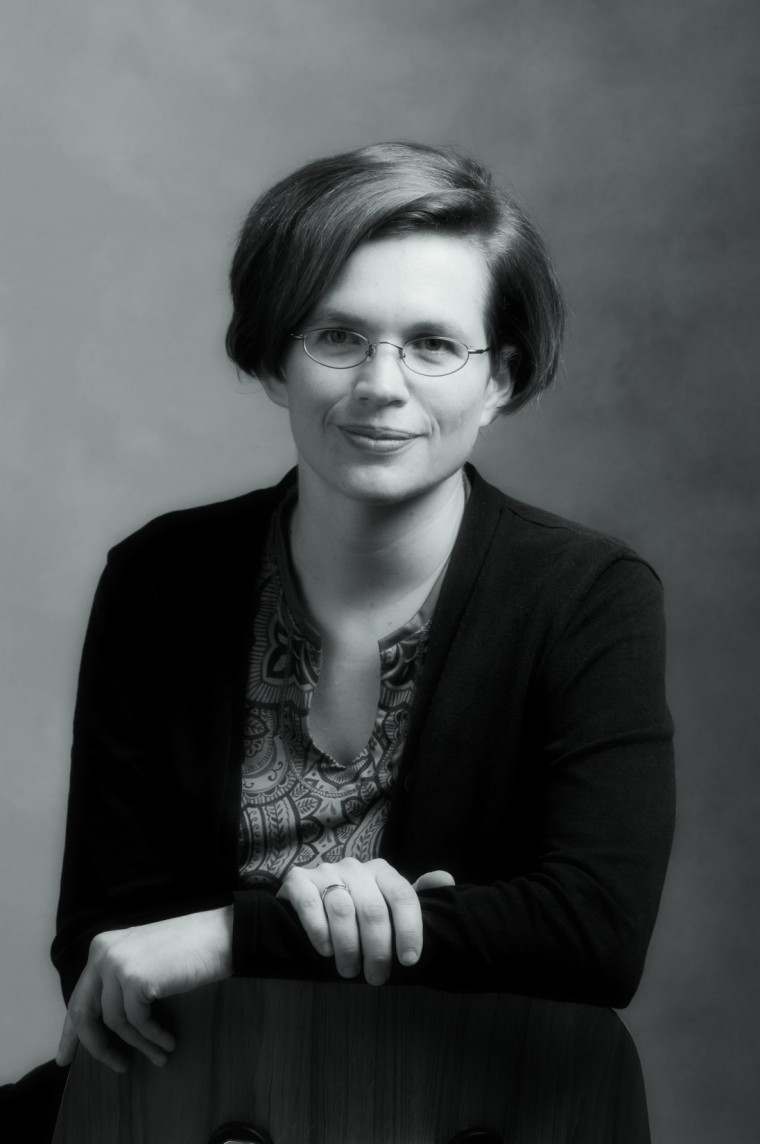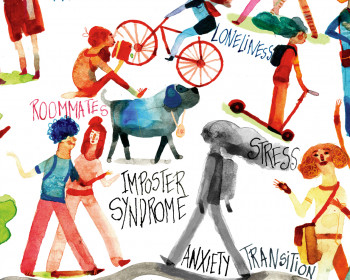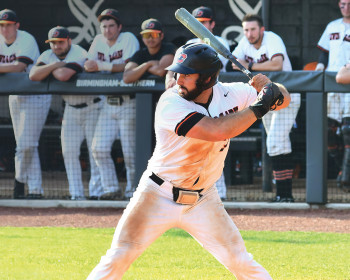The Science of Small
Anne Bentley is a rising star in the miniature world of nano.
Open gallery

Anne Bentley is a rising star in the miniature world of nano.
by Bobbie Hasselbring
Photography by Robert Reynolds
It’s a small world–very small.
At least that’s how it is for Anne Bentley, assistant professor of chemistry. She’s one of an elite cadre of researchers in the cutting-edge field of nanotechnology–the study and control of particles that are too small to be seen or touched but are powerful enough to transform everything from sunscreen lotions to automobile fuel cells.
Just how small is nano? So small that it involves structures that are less than 100 nanometers in diameter. One nanometer is one billionth of a meter. It would take 5,000 nanometers to fit across a single blood cell. (See “How Big Is Small?” below.)
What’s significant about nanoparticles is that their properties behave differently than those of the same material in larger sizes. Bentley points to a silver ring she’s wearing. “This ring looks silvery white. However, I have silver nanoparticles in the lab that look yellow. Because of their small size, nanoparticles interact and resonate differently with incoming light, which changes the color of the material.”
By simply changing the size of particles, researchers can dramatically improve a material’s properties. Composites made from particles of nanosize ceramics or metals suddenly become much stronger than would normally be expected. For instance, metals embedded with 10-nanometer particles are as much as seven times stronger than metals made with larger particles.
Why does size make such a difference? Decreasing the particle size increases the surface area when compared to the same mass of material produced from larger particles. Imagine two pieces of gum–one chewed into a wad, one stretched into a thin sheet. The surface, or area visible on the outside, is much greater for the sheet of gum than for the wad. The thin sheet will dry out and become brittle faster than the wad, since the sheet has more contact at the surface with the air moving around it. On the nanoscale, scientists have used this increased surface area to store more data on computer chips.
The increased surface area brought about through nanotechnology means more availability for interactions with other materials; therefore, nanomaterials can be more chemically reactive than their counterparts made from larger particles. In some cases, materials that are nonreactive (inert) in the larger scale become chemically reactive in nanoscale.
Additionally, quantum effects can begin to dominate the behavior of matter at the nanoscale. An effect that may seem too small to be significant on the larger scale can have a big impact on the nanoscale and can change the optical, electrical, and magnetic behavior of materials.
Nano changes aren’t always good. Sometimes they’re even dangerous. “There was an explosion at a sugar refinery in Georgia last spring that killed a number of people,” says Bentley. “Over time, as sugar is refined, the processing creates very, very tiny bits or nanoparticles of sugar that are smaller than the sugar crystals we can see. If the manufacturer doesn’t have a good cleaning system, dangerous levels of this nanodust can build up. In this case, a spark ignited the dust and caused the explosion.”
Nano Wrangler
Controlling nanoparticles and their properties is where scientists like Bentley come in. “Because nanoparticles are so tiny, we can’t see them and physically manipulate them,” she explains. “But if we can control the chemistry of the surface of the particles, we might be able to influence their attraction in one direction or another. I’m trying to find ways to control how many nanoparticles are in one place so we can better control their properties.”
While tens of thousands of nanoparticles could fit across a strand of hair, Bentley is working to corral them onto thin film sheets. The “rope” this nano wrangler is using to round up her tiny particle herds is electrochemical deposition (also called electroplating). This technique produces a coating or film, usually metallic, on a surface by the action of electric current. The object to be coated is immersed in a salt solution. When a negative electric charge is applied, the positively charged particles (ions) of the salt are attracted to the object and form a coating or film. In Bentley’s work, the nanoparticles she’s interested in are added to the salt solution, and the electrochemical reaction that occurs when she applies the electric current acts to drive them into the film. “I’m trying to trap the nanoparticles in the film as it grows,” she explains.
Although other scientists are also working to control nanoparticles and their properties, Bentley’s approach is unique. It’s also elegantly simple, precise, and, perhaps best of all, inexpensive. “Most thin-film work requires a high-vacuum system that rains particles down onto a surface. It’s very expensive. Electrodeposition is cheap and easy to control. You can manipulate the thinness of the film and what’s in the film by just changing small parameters.”
Kyoung-Shin Choi, an associate professor of chemistry at Purdue University and Bentley’s postdoctoral faculty advisor, explains the significance of Bentley’s work: “Tuning the fine features of the nanoparticles and composite films will allow for enhancing various desired properties–optical, mechanical, and catalytic. Her research will enable us to increase the efficiency and stability of films for use in various applications without the need for expensive techniques or extreme conditions.”
Bentley’s experiments could have far-reaching impacts on the research world and in our everyday lives. Successfully controlling and organizing nanoparticles could enable them to be used in a wide range of products, from sensors to advanced batteries. One material she’s studying is used as a cathode in lithium ion batteries for laptop computers. As anyone who’s used battery-powered computers knows, the life cycle of the batteries can be woefully short. Bentley’s research could help them operate longer and enable them to be recharged indefinitely.
The Magic of Nano
For Bentley, the draw of nanoscience is its seemingly magical properties. “Nanoscience underlies so many things,” she says. “In nature, for instance, certain bacteria make magnetic nanoparticles that enable them to orient to magnetic north. A scientist might look at these bacteria under the microscope and ask, ‘I wonder why they’re all pointing north?’ Nanoscience explains it. It’s the underpinning magic.”
Nano may be magic, but it’s no boutique science. Nanoscience is part of many fields, including chemistry, biology, zoology, and physics. It’s both the interdisciplinary nature of nanoscience and its rise in modern science that make it a natural for Lewis & Clark. “Nanoscience is a new frontier–the gateway to so many new technologies that take advantage of the unique properties of very small materials,” says Julio de Paula, dean of the College of Arts and Sciences and a chemistry professor who himself conducts research in nanotechnology. He says the college is expanding both the research and its curriculum offerings for students in nanotechnology.
The challenge of working in the “unseeable” scale is part of what fascinates Bentley about the chemistry of nanoscience. “The growth of technology–like sophisticated microscopes that let us see particles–has enabled the growth of nanotechnology,” explains Bentley. “It’s kind of a chicken-and-egg thing. We couldn’t study this field until we had the techniques and instruments we needed.”
A favorite instrument for Bentley is the spectrofluorometer, a device that enables researchers to monitor how particles are glowing. “A lot of biologists and chemists use this tool,” she says. “It shines certain wavelengths of light in and monitors what comes out, and by looking at the patterns, you can tell you whether you’ve made the correct particles.”
Another powerful tool is the scanning electron microscope, a tool Kellar Autumn, professor of biology, also uses in his work studying gecko adhesion. The availability of these instruments was one of the reasons Bentley chose to come to Lewis & Clark. “It was important to me that the college where I ultimately decided to work would have some of this sophisticated technology.”
Returning to the Northwest was another big draw. For someone who grew up in the Seattle area, taking a job at Lewis & Clark meant coming home. She often hops the train for the short ride north to visit family. The proximity of the mountains enables the avid backpacker to indulge her passion for hiking. And bike-friendly Portland allows her to ride from her home to work several times a week.
Lewis & Clark chose Bentley for her experience in both research and teaching. “Anne presented us the perfect combination of a promising teacher and a promising scholar in an area Lewis & Clark really wants to grow,” says de Paula.
Transforming the Lab Experience
Not only is Bentley at the forefront of nanoscience, she’s a leader in the movement to transform the way laboratory science is taught. As a postdoctoral researcher at Purdue University, Bentley was part of the Center for Authentic Science Practice in Education (CASPE), a group that’s creating a curriculum model for teaching laboratory science to first- and second-year college students.
“There’s a question in the education community about the purpose of the lab experience,” she says. “Some say it’s to teach laboratory skills; others say it’s to reinforce the lecture content. But a lot of studies say the way we use the lab is not very successful.”
Most first- and second-year students come to a lab and follow a strict set of directions. In contrast, Bentley and her Lewis & Clark colleagues ask beginning students to tackle real research questions and learn laboratory skills from the start. “We want to teach students how to think and ask questions like researchers. We also want to teach them how to analyze data and recognize whether it answers the research question or whether they need to do additional experiments.”
Gabriela Weaver, professor of science at Purdue and CASPE’s director, was Bentley’s faculty advisor and knows firsthand about her dedication to laboratory education. She says that Bentley’s work moves toward teaching science “in a way that better reflects the types of scientific thought processes that scientists engage in. She is personally invested in her teaching, and this shows through her hard work and enthusiasm.”
Recently, Bentley won a $100,000 National Science Foundation grant to create a model laboratory curriculum that will be used both at Lewis & Clark and at Portland Community College’s Sylvania campus. The idea is to captivate students with laboratory research experience early in their undergraduate careers. One goal is to encourage community college students to go on to study science at Lewis & Clark or other four-year colleges. “We’re losing future scientists who, with just a glimpse of actual research, might get excited enough to continue in science,” Bentley says. Under this new curriculum model, she believes, “Students will be getting a high-level introduction to research laboratory work and a big dose of problem solving.”
That kind of authentic exposure has already influenced two of Bentley’s students who worked with her in the lab this past summer. Daniel Bae, a junior who is considering a double major in biochemistry and psychology, says that although he doesn’t see himself becoming a research scientist, Bentley’s enthusiasm is “very contagious.” Her insistence that students record their experiments changed how he works. “I’ve never been good at writing down results, and getting that discipline under Professor Bentley has really helped me develop as a scientist.”
Sophomore chemistry major Eric Randall says, “I used to think research was dull and repetitive. Professor Bentley has shown me the enjoyable parts of research–the problem solving, the critical thinking, and the rewarding feeling of making progress.”
According to de Paula, Bentley’s nanotechnology work represents a step into the future for the country as well as the college. “Nanotechnology represents a competitive advantage for the United States in science and technology, and now Lewis & Clark can provide our students opportunities in this field and introduce them to research methods that prepare them for the future. Anne Bentley is poised to make a splash nationally in nanoscience, and she’s doing so by involving our undergraduates. That’s really exciting.”
Award-winning freelance writer Bobbie Hasselbring writes for a number of college and university publications. Her most recent story for the Lewis & Clark Chronicle, “Sticky Business,” profiled Professor of Biology Kellar Autumn.
More L&C Magazine Stories
Lewis & Clark Magazine is located in McAfee on the Undergraduate Campus.
MSC: 19
email magazine@lclark.edu
voice 503-768-7970
fax 503-768-7969
The L&C Magazine staff welcomes letters and emails from readers about topics covered in the magazine. Correspondence must include your name and location and may be edited.
Lewis & Clark Magazine
Lewis & Clark
615 S. Palatine Hill Road MSC 19
Portland OR 97219

